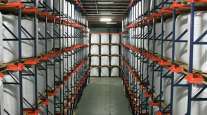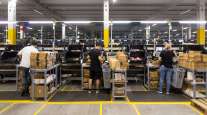Warehouse Operators Look for ROI, Advantages in Automation

[Stay on top of transportation news: Get TTNews in your inbox.]
A tight labor market along with advances in warehouse robotics are the top reasons operators are beginning to make larger investments in automation. It’s a strategy to overcome not only a workforce shortage but also the supply chain issues that have disrupted distribution across the industry.
Robotics and other automation technologies can handle picking, sorting, stowing, packaging and a variety of transportation-related tasks in a warehouse. Operators point out that the robots work 24-hour shifts without drawing a paycheck or taking a vacation. However, the most narrowly focused robotics systems can require close to a $1 million capital investment, and to fully automate a major distribution center might cost more than $20 million.
With automation, warehouse operators are hoping see a return on investment (ROI) in a reasonable period of time, but experts differ on what that is and how it should be defined.
According to Akash Gupta, CEO and co-founder of robotics automation manufacturer GreyOrange, expected ROI will vary from a few months to several years depending on the procedure to be automated and the nature of the process to which it’s applied. For example, the difference between a goods-to-person application and a person-to-goods application could lead to ROI variance of up to 400%.
“And even within either of the applications, a combination of robotic agents directed by a multiagent orchestrator could improve overall ROI by as much as 50%,” Gupta said. “Regardless of these constraints, any automation solution should have an ROI of less than 36 months and should then progressively keep improving the operating costs by continuously becoming smarter.”
Cindy Crawford, group director of maintenance and engineering at Ryder, said customers tend to expect quicker ROI with simpler automation, but the financial situation of the customer sometimes puts pressure on a warehouse operator to deliver results more quickly.

Warehouse operators have found that robotics delivers a surprising return by upgrading what was thought to be a highly accurate operation. (Ryder System Inc.)
“We find that the ROI answer varies a lot depending on the size and scope of automation,” she said. “If you’ve got a single, simple robot solution to a very highly integrated system of lots of different automation elements, much more complex, we find that customers seem to be interested in a payback that’s somewhere two years or less, depending on the financial situation of that customer.”
According to Kevin Stock, executive vice president of engineering for Geodis in the Americas, the likely ROI time frame on simple technology with minimal infrastructure could be two years. But warehouse operators, he explained, will have to wait longer to come out even on more extensive investments.
“For more complex technologies with significant initial infrastructure required, the payback period is generally five years or less,” Stock said. “In essence, the exact payback period of warehouse automation depends on a number of variables that are specific to the operation, including the automation type, size, scale, customer contract, term length and more.”
Geek+ is a Beijing-based robotics provider that produces various models of picking robots. Rick DeFiesta, executive vice president of sales and solutions in the Americas for Geek+, tells warehouse operators the ROI timing range can be as wide as the definition of ROI itself.
“We’ve seen ROIs from 18 months, but larger systems may be as much as five years,” he said. “But it’s also the thing you can’t measure, which is lost business.”
Realizing the Return
Traditional understandings of ROI start by noting the capital invested up front, then measuring accumulated savings or added revenue over time to determine when the two numbers become equal. DeFiesta makes the case that some benefits of automation can never be known with certainty — like the value of business one might have lost if not for the capital investment.
Success in the warehouse/distribution business depends on critical measures such as speed and accuracy. Even operations that have seemingly elite-level performances in these areas can realize quick and significant returns on investment — the kinds that may not fall under traditional ROI measures — if they can find a way to do better through automation.
Neil Shelton, chief strategy officer for GXO, said his company found out recently that robotics could deliver a surprising return by upgrading what was thought to be a highly accurate operation.
“We took over a site a couple years ago and that site went from 98.5% accuracy to 99.9999% accuracy,” Shelton said. “That is 30 million items no longer sent out incorrectly. That is a huge difference. We put in a series of collaborative robots for the customer, which means we’re able to drive up the speed and turnaround.”
For many years, loss of operational flexibility was considered one of the trade-offs of warehouse automation. Whereas people could be easily moved around as necessary, robotic technology could be expected to operate efficiently but not with much agility.

With automation, DHL Supply Chain has been able to reduce its onboard training time while providing more value-add tasks for its employees. (DHL Supply Chain)
But operators in today’s market say that has changed. More advanced robotic systems not only offer more flexibility than their predecessors, but they also help make the workforce more agile.
“When you think about the old days of automation, it was pretty rigid,” said Omer Rashid, vice president of operational excellence in automation/innovation/analytics for DHL Supply Chain. “But that’s where robotics has helped us. It’s really about automated mobile robots, which are less heavy-duty, so they handle smaller payloads of 40 to 60 pounds. They can navigate through our warehouses safely.”
That sets up a situation in which human employees — no longer asked to handle the riskier and more physically demanding tasks — can be moved around more easily since the robots are handling things like picking and packaging. Most operators also indicate the expansion of automation simplifies worker training.
According to Gupta, automation adds flexibility because workers can be easily trained to move between different processes and maintain higher levels of productivity — while reducing worker turnover in the industry.
“A software layer that can manage automation throughout different processes adds the flexibility for workers to be able to perform different tasks within the same day and shifts the workforce between these processes when required,” Gupta said.
Labor Effect
While automation is often associated with job losses, operators say that has not been the case in recent years in warehousing.
At GXO, the company added 15,000 employees worldwide in the past 12 months, which Shelton attributes directly to the role of automation in creating a more engaged workforce and a more agreeable work environment.
“Technology is having a very positive impact on the overall work environment,” he said. “It takes out material handling equipment, forklifts and so forth, and that makes the work environment a safer place. It reduces training time. It helps employees to feel productive more rapidly.”

This special "Inside the List" episode features the Transport Topics 2023 Top 100 largest logistics companies. Hear the program above and at RoadSigns.TTNews.com.
GreyOrange’s Gupta noted that high-level automation actually makes the process of training workers much easier. “Automation, backed by an intelligent software execution layer, can take the complexity out of operations by orchestrating workers, robots and inventory to optimize various processes and enhance worker productivity,” he said.
Rashid said DHL Supply Chain used to take at least a full 40 hours to onboard a new employee, but because robotics has replaced many complicated tasks, training time is significantly reduced.
“Now it can be done in a matter of hours, so the ease of training and learning how to interact with the automation has been a big game-changer,” Rashid said. “And taking away the difficult parts of their jobs, not having to walk miles a day to select items, not having to worry about lifting heavy items anymore — the work has become easier and that’s a value-add.”
According to Stock, Geodis is using a system from Locus Robotics that simplifies training by making the automation more intuitive to each worker.
“Locus Robotics has a user-friendly interface that has the ability to recognize an employee’s identity via their badge and display text in their native language,” Stock said. “This has an incredible benefit for reducing teammate training time.”

Providers contend that high-level automation enhances worker productivity and efficiency. (Ryder System Inc.)
Although robots don’t present disciplinary issues, they can be susceptible to mechanical failures. Warehouse operators and technology providers said they deploy a number of protocols to mitigate the risk of automation failures, some of which include modular designs that prevent a single machine failure from becoming a systemwide breakdown.
“What we offer is pretty much eliminating any single point of failure,” DeFiesta said. “Think about a fixed infrastructure system like a conveyor system, and what happens if it goes down. Compare that to a system that has 100 bots. If I have one bot go down, I’m only down one bot.”
And while they’re not paid labor, robots still take a considerable amount of time to pay for themselves. The industry hopes the residual benefits along the way make the ROI worth the wait.
In the case of GXO, an employee worked with a technology provider to develop an AI-based tool that would oversee the automation. Problems like a hanging piece of plastic, which might have sent a robot into shutdown mode, are now addressed automatically through the AI tool.
“This teammate put this in place and it drove 42 minutes of extra up-time for the automation per day,” Shelton said. “That’s massive.”
Want more news? Listen to today's daily briefing below or go here for more info:




